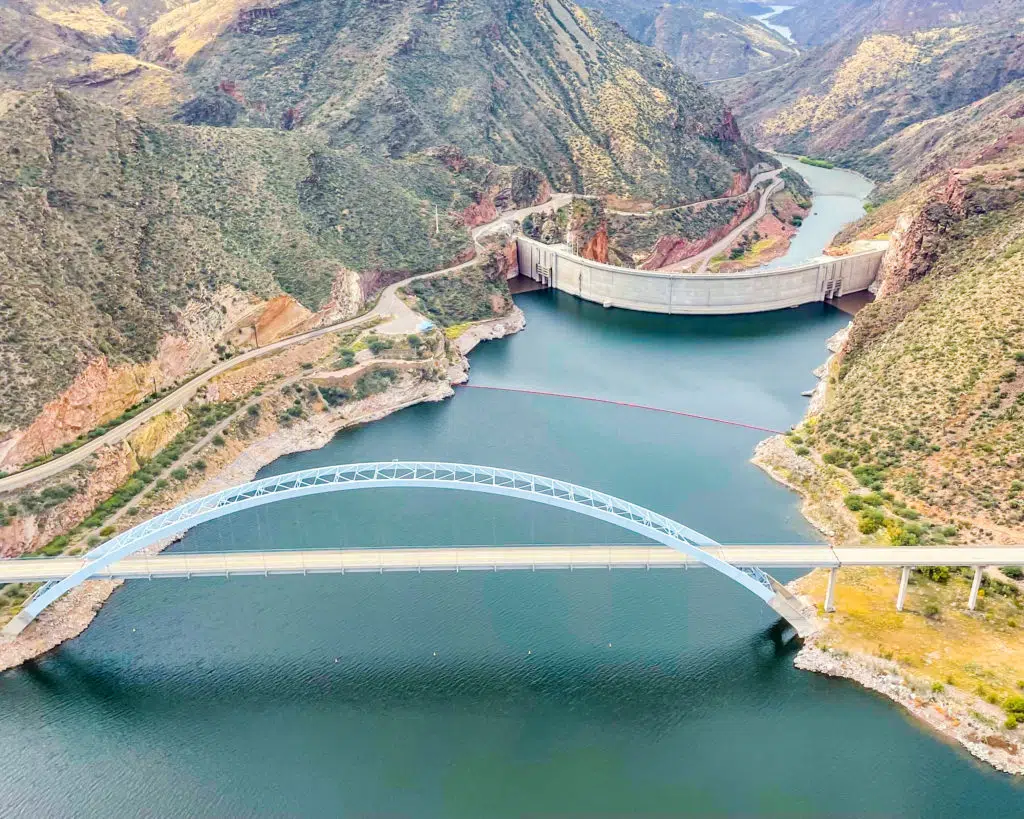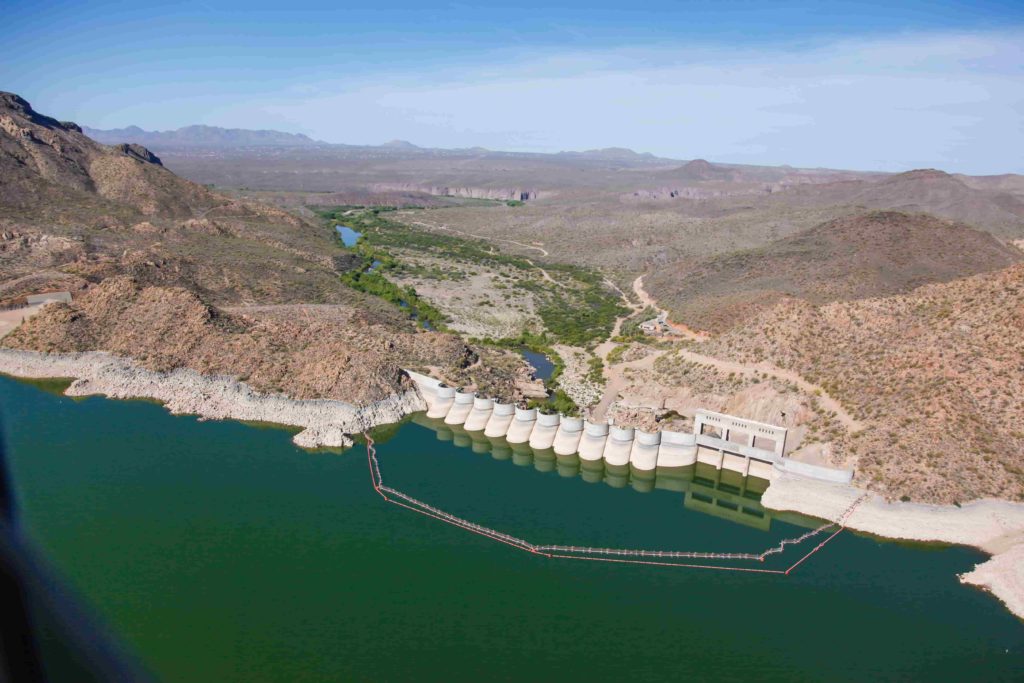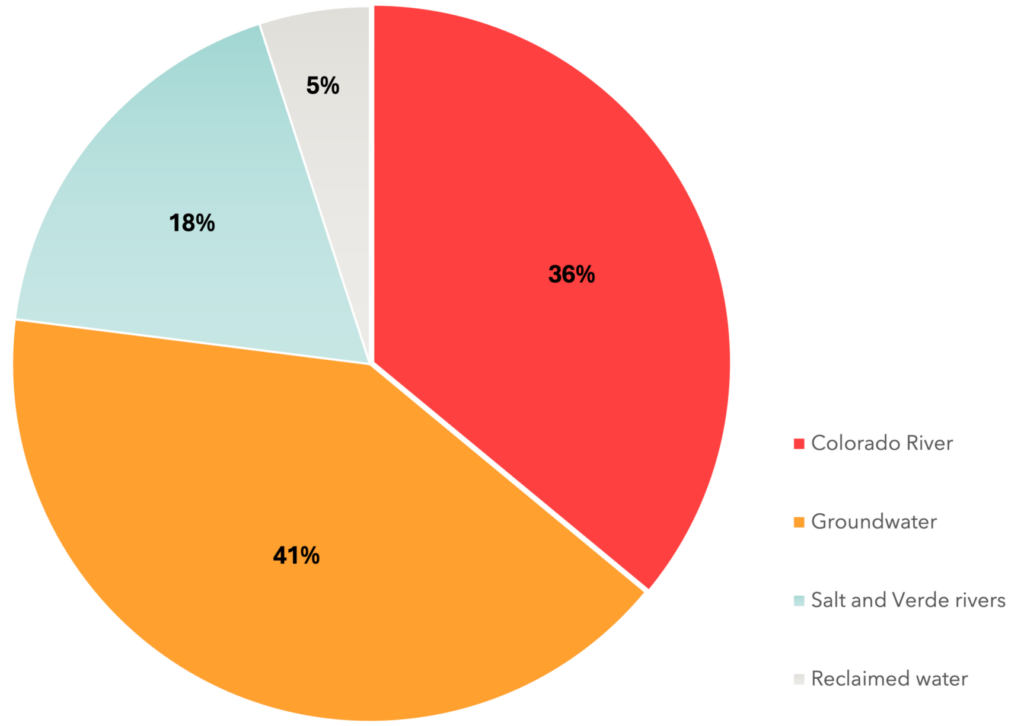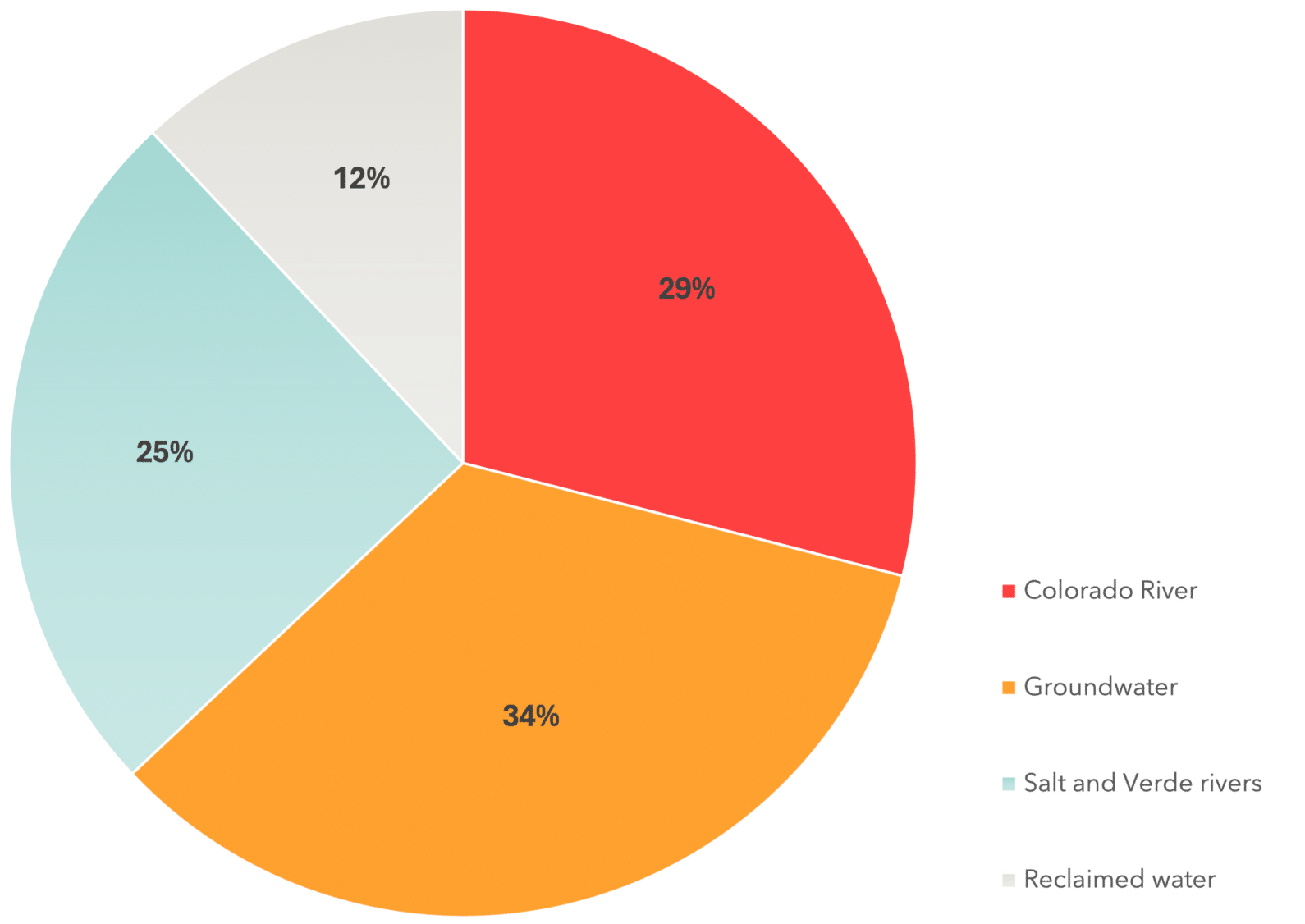
Understanding Arizona’s Water Position
Water is a precious resource in Arizona and stewardship has been a priority since before statehood. From canal and dam construction in the late 1800s and early 1900s, Colorado River treaties and compacts with neighboring states and Mexico preempting the Colorado River Basin Project Act in 1968 to the 1980 Groundwater Management Act, Arizona’s growth in the 20th century was centered around intentional, proactive water management.
Arizona uses roughly the same amount of water today as it did in the 1950s despite a 7x increase in population and 15x economic increase thanks to increased conservation methods and reduced agriculture demand. Regional leaders recognize the challenges of planning for a resilient water future, and with innovation and more than $5 billion in funding available at the state and federal levels, Arizona is actively advancing its efforts for conservation, distribution and augmentation to address future water needs.
By the Numbers
89%
of water in the waste stream gets reclaimed
12M
acre-feet of water is stored in AZ reservoirs & underground
100
AZ communities within an AMA must assure a 100-year water supply before platting new development
Where does water in Arizona come from?
Greater Phoenix and Arizona have four main water sources: groundwater, Colorado River water, Salt and Verde River water, and reclaimed water.
Most groundwater used in the state is fossil groundwater. In-state surface water, reclaimed water and Colorado River water are all renewable, with rivers such as the Salt and Verde replenished by annual precipitation. Because of these regulated and largely renewable water sources, Arizona is less reliant on the Colorado River than neighboring states in the basin that share its water.
Arizona Water Sources
Greater Phoenix Water Sources
Colorado River
For decades, Colorado River water and reclaimed water have been used to recharge and replenish aquifers in Greater Phoenix. The federal government, states and tribes that share the river, and Mexico have worked to shore up water levels in Lake Mead and they continue to work for a resilient future on the Colorado River.
The Colorado River Basin was upgraded from a Tier 2 shortage to a Tier 1 shortage in 2024. To backfill the shortage in the short-term, municipalities will use groundwater and other supplies while promoting conservation programs to reduce outdoor water use and commercial cooling water use. See long-term plans here.
Surface water
The majority of Arizona’s surface water comes from Salt River and Verde River, both managed by the Salt River Project (SRP). These watersheds are less susceptible to climate change than the Colorado River is, providing a more reliable source. The annual water demand in this system has declined over the last few decades.
SRP water is available to many cities in Greater Phoenix. About 25% of tap water comes from the Salt and Verde rivers, while groundwater provides 34% and the Colorado River makes up 29%.
Groundwater
Arizona was the first state to plan for a 100-year water future by passing the 1980 Groundwater Management Act, which established the legal and physical infrastructure to assure a 100-year water supply in Active Management Areas (AMAs).
Seven areas with heavy reliance on mined groundwater were identified and designated as AMAs to help meter, regulate and report on groundwater use. Municipal water providers, industrial users, and agricultural water users have been subject to these requirements since the First Management Plan became effective in 1987.
Groundwater levels are generally stable or improving in Greater Phoenix.

Arizona Water Management
Arizona’s total annual water demand is around 7 million acre-feet, and each municipality, community and water provider has its own portfolio of supplies to manage the demand.
The 1980 Groundwater Management Act regulates the use of groundwater, specifically through Irrigation Non-Expansion Areas (INAs) and Active Management Areas (AMAs).
- In INAs, wells larger than residential are metered. Groundwater usage is required to be reported annually.
- AMAs require metering and reporting of groundwater use, prohibit new irrigated agriculture, and require proof of 100-year water supply availability before a development of six or more homes can be platted.
Every 10 years, the Arizona Department of Water Resources (ADWR) develops a new management plan for each AMA with the aim of achieving “safe yield” — the long-term equilibrium of groundwater withdrawn and replenished.
There are seven groundwater basins within the Greater Phoenix AMA. Over the last 10 years, groundwater levels have increased in the Carefree Basin and the East Salt River Sub-basin but decreased in the Rainbow Valley sub-basin. The other four sub-basins have been stable.
Recent Developments
October 2025: EPCOR receives Alternative Designation of Assured Water Supply
In 2023, as a result of the Arizona Department of Water Resources (ADWR) study showing a shortfall of approximately 4% of unmet groundwater demands over the next 100-year period, Gov. Katie Hobbs established the Governor’s Water Policy Council to modernize the Arizona Groundwater Management Act. Among policy recommendations from the council was the creation of the Alternative Designation of Assured Water Supply (ADAWS), which gives providers new flexibility to acquire non-groundwater supplies from outside Greater Phoenix.
Following a two-year moratorium on new water supply certificates in the Phoenix Active Management Area, water provider EPCOR Utilities Inc. was granted the first ADAWS in October 2025, extending 100-year water supply protections across EPCOR’s service area in the West Valley. This designation applies to 140,000 residents and could lead to the development of 60,000 new homes in the area.
EPCOR’s water supply consists of groundwater, the Colorado River and Lake Pleasant, and the provider plans to replenish groundwater supplies by putting 96% of treated water back into an aquifer through a partnership with the Maricopa Water District.

Looking to the future
Arizona continues to bolster investments in a multi-faceted portfolio of water supplies. In January 2025, the state allocated $60.3 million to fortify water infrastructure and the Water Infrastructure Finance Authority (WIFA), which in 2022 received significant budget allocation for long-term water planning including:
- Water Supply Development Revolving Fund for projects needs of small, rural communities outside of Arizona’s major urban centers.
- The Long-Term Water Augmentation Fund, a $1 billion investment for projects that import new water supplies.
- $200 million for the Water Conservation Grant Fund that has supported 150 projects, with an additional $14.6 million allocated in January 2025.
The state’s intentional water planning makes the subject less daunting than other environmental challenges faced across the U.S:
- Compared to building expensive infrastructure to minimize the harm caused by floodwater or rising sea levels, moving a defined quantity of water to bolster Arizona’s supply is more attainable and affordable.
- Groundwater in Greater Phoenix has been protected through the 1980 Groundwater Management Act as a fallback supply for times of Colorado River shortages.
In addition to desalination as a long-term goal, future water resources could include brackish groundwater, direct potable reuse of reclaimed water, transfers of Colorado River water rights or limited inter-basin transfers of groundwater.
Families and businesses considering a move to Arizona can trust that water security is a serious focus for both public and private leaders in the region.


